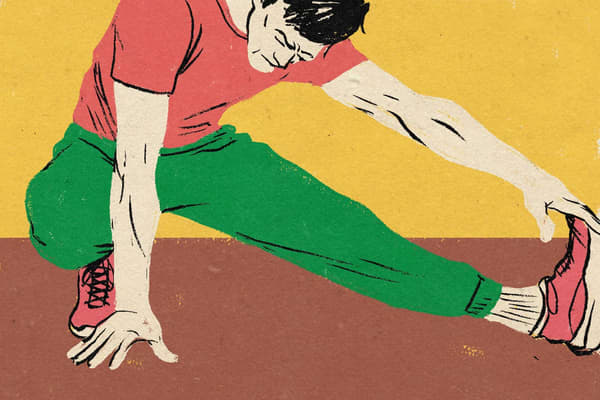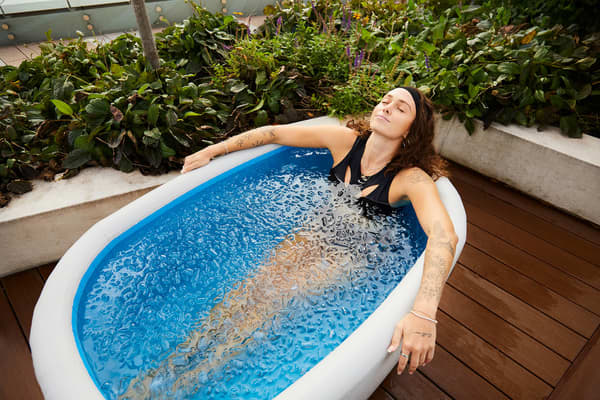What Are Compression Boots—And How Do They Work?
Health & Wellness
Experts share everything you need to know before using compression boots for workout recovery.

Over the past few years, compression boots have become a popular recovery method for athletes.
Walk into a physiotherapy clinic and you'll probably see a few folks wearing inflatable boots. Here's why: The compression the boots provide has been shown to alleviate soreness and promote healthy circulation. But do recovery boots really work? And are they worth the price tag? (Most compression boots cost between a few hundred and a thousand pounds.)
Below, physiotherapists and certified personal trainers explain how compression therapy works, the science of recovery boots, and how to get the most out of your recovery routine.
(Related: What's the Difference Between Dry Needling and Acupuncture?)
What Are Compression Boots?
Compression boots are hollow, fabric boots that cover the feet, lower legs and thighs that contain multiple chambers. Each of these sleeves fills with air, one after the other, to compress, or squeeze, one section of the lower body at a time—starting at the feet and working up towards the hip.
This process is called intermittent pneumatic compression or IPC, and medical professionals have long used it to reduce foot and leg swelling in patients with serious health conditions such as lymphoedema, deep vein thrombosis or pulmonary embolism.
How Do Compression Boots Work?
In patients with oedema, compression boots help push deoxygenated blood from the lower body back up towards the heart.
"It's almost like squeezing a tube of toothpaste from the bottom", Audra Wilson, CSCS, said.
In athletes, intermittent pneumatic compression largely works the same way—but the toothpaste in question isn't just blood. It's the post-exercise inflammation it carries.
"Compression boots help move the 'bad' metabolic by-products from the lower leg back into the circulatory system to be pumped throughout the body", said Sam Becourtney, DPT, CSCS, "and replace it with 'new' and 'freshly' oxygenated blood, which promotes an environment for muscular healing and recovery".
Potential Benefits of Recovery Boots
Proponents of compression boots explain that by encouraging the body to flush out metabolic by-products (such as lactate) after exercise, the boots reduce water accumulation, inflammation and muscle tension. And, by allowing tissue-repairing compounds to rush into the damaged muscles, they can reduce recovery time and improve exercise results, Becourtney said.
It's important to know, though, that the body automatically does this on its own after each workout—with or without the help of external devices. Meanwhile, other recovery techniques like yoga and foam rolling are shown to help via some of the same mechanisms.
So, for the vast majority of athletes—especially those who already get sufficient recovery between their training sessions—compression boots are unlikely to dramatically improve results.
But, for professional or highly competitive athletes, it can be the difference between winning, losing and even injury. Many of these athletes push themselves to the edge of what their bodies can handle. When that's the case—and an athlete only has a few hours to recover between training sessions or competitions—every little bit counts, Wilson said.
Do Recovery Boots Really Work?
While several studies agree that intermittent pneumatic compression increases lower-body blood flow, research on how this influences training recovery is relatively new—and, at times, a bit conflicting.
For example, some research suggests compression devices can help keep flexibility up and muscle tenderness low in the days following tough strength sessions. However, in a study—published in a 2020 issue of the International Journal of Exercise Science—long-distance runners reported no benefit in reducing delayed onset muscle soreness.
Meanwhile, a 2021 review concluded that while intermittent pneumatic compression may provide short-term relief of delayed onset muscle soreness, it probably does not reduce markers of exercise-induced muscle damage in athletes.
So do compression boots actually work? It might depend on the athlete—and their mindset.
"The power of mental buy-in and the psychology of pain cannot be understated", Becourtney said. "Regardless of the actual physiology or mechanism behind them, when wearing the boots, you certainly feel something happening, and this alone has immense value".
How to Use Compression Boots
If you want to try compression boots, go for it. Test out a pair at your gym or a physiotherapy office—and go from there. In the end, you're the only one who can decide if they're worth it for you.
Though, bear in mind that it's always a good idea to consult your doctor before trying a new recovery method.
1.Talk to a Physiotherapist Before Using
While compression boots are relatively low risk, it's always best to try them with a physiotherapist's supervision prior to using them on your own. Do not use following surgery or injury without medical clearance, Becourtney said.
2.Wear Loose Clothing
Remove shoes and any compressive clothing before using leg compression boots. These, combined with the compression from the device, can become excessive and uncomfortable, Becourtney said.
3.Keep Sessions Short
Your physiotherapist will be able to recommend the right amount of compression time for your body, but 20 minutes is plenty of time for most athletes, Wilson said.
Avoid using compression boots for more than 30 or 40 minutes at a time, Becourtney said.
4.Use Them After Exercise
Compression therapy is best reserved for after tough workouts like lifting, running or cycling, Becourtney said. Use them after your cool-down routine to start your recovery process.
5.Use Them as a Workout Recovery Add-on
Recovery boots are not a replacement for light recovery workouts, stretching, foam rolling and good nutrition, Wilson said. Turn to them as a way to complement the fundamentals of healthy recovery.
Words by K. Aleisha Fetters, CSCS





